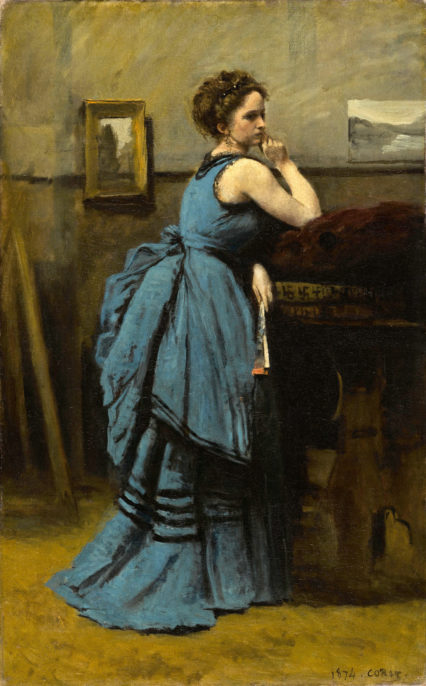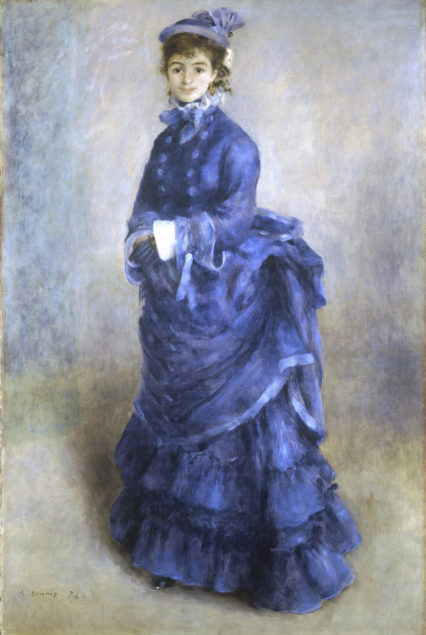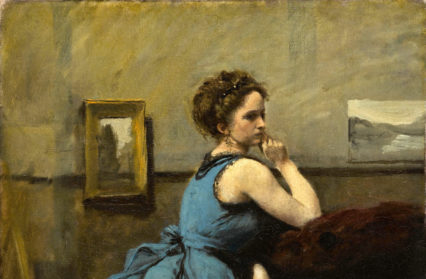Inspired by the closure of museums and art galleries caused by the current lockdown, Nigel Jarrett takes a closer look at two French paintings of women in blue, Corot’s The Woman in Blue and Renoir’s La Parisienne.
A pandemic lockdown affords opportunities for two distinct but related activities: the summoning of one’s capacity for survival and self-protection and the remembrance of what one is missing. They are related through meditation: survival beyond the practical steps needed to accomplish it turns one inwards to the self as something vulnerable and at risk, while consideration of what one is temporarily deprived of involves a deeper appreciation. This is always an existential position, its pandemical specifics defined by what will be temporary removal and loss. That such an experience can also prompt and encourage re-evaluation at a distance seems self-evident: what we are used to but for the time being set apart from not only feeds the desire for re-acquaintance but also the expenditure of a more detailed and objective assessment.

The closure of museums and art galleries offered the quaint if pathetically fallacious proposition that the objects inside them, forever static and inviting examination, were resting from our gaze, like mysteries freed from scrutiny and solution. Without enforced domesticity, I might not for a while at least and by sheer accident have surfed something about the painter Corot on the internet while looking for Coronavirus, hitting a ‘t’ instead of the fifth letter ‘n’, and activating Google’s ready capacity for anticipation, which, like predictive text, always comes up with off-target suggestions. But once a browser has slipped the leash and found its bearings, it offers up everything: in this case, a washing line of pictures by Jean-Baptiste-Camille Corot (born Paris, 1796; died Paris, 1875), including The Woman in Blue, painted in the year before his death and now displayed in the Louvre.
I’d never before thought to compare the Corot painting with Renoir’s La Parisienne, also of a woman dressed in blue and the centrepiece of the ‘French Impressionists’ collection at the National Museum of Wales in Cardiff. Renoir was thirty-four when he completed La Parisienne in the same year as Corot painted his picture at the age of seventy-eight. La Parisienne was shown at the First Impressionist Exhibition. Renoir’s model cannot have been much younger than Corot’s but there the resemblance ends. She was Henriette Henriot, an actor at the Odéon during the 1860s and transformed by Renoir into a stereotype of coy vulnerability. The transformation is also formal in that Renoir seems to have sacrificed character and anatomy for sensual indulgence, so much so that the woman’s head is out of proportion to the rest of her body and the metamorphosis from ‘madame’ to ‘mademoiselle’ complete. Corot’s model, a professional, was Emma Daubigny, daughter of the artist Charles-Francois Daubigny. She had posed at least twice for Corot and possibly more than once for Degas. The loose subject-matter of both pictures is portraiture, and the stylistic distinction made between Corot the Realist and Renoir the Impressionist is historical convenience (Renoir was a Realist of the Parisian scene and its young hedonists as well as a Hellenistic poet in paint). The subtitles might also be La Couleur Bleue, bright and vocal in Renoir, olive-deep and subdued in Corot. Both women were without doubt clothes-horses for the occasion.

The trend today is away from the idea that pictures (and art in general) cannot be understood without the shouldering of knowledge aforethought and its dumping beside the viewer and the thing viewed as contemplated image. This is nowhere more vindicated than in comparing these two pictures; without a comparison it would be more difficult. Renoir self-evidently invests everything in what his model looks like in a dress that seems too sophisticated for her, its bulk assertive in reducing its wearer to features which skittishly peep out: the head, the hands, and the single foot that one critic likened to a timid mouse hiding in the skirts; whereas, Corot could not fail to convey the much more profound idea of a paradox: that his model, probably having slipped into her dress as a mere studio prop rented or borrowed, is just as suited to it as the woman, higher in social status, to whom it once belonged. Renoir’s investment is so heavy that his model’s surface prettiness – and that’s all it is – becomes sartorially subjugated; but Corot’s opens up a range of semantic possibilities, not the least of which is the clear illustration of the emptiness of class division, one almost endorsed by the model herself and the emotion of barely-suppressed ennui she expresses, maybe at the end of a hard day at the studio. Corot’s model has attitude; Renoir’s has none except perhaps pliability. Corot’s has lost all self-consciousness, even of the detailed surroundings with which she must have been familiar; Renoir’s displays little else, and there is no background to be familiar with, unless one recognises a perfumed Impressionistic smog. Corot’s model is Emma; Renoir’s is Henriette (but it doesn’t matter): Henriette says, ‘Look at me. What do you think?’; Emma says, ‘Look at me if you want, but I couldn’t care a centime what you think.’ Even by the conventions of the day, Henriette’s gaze outwards seems less unusual and meaningful than Emma’s ruminative, back-to-the-viewer stance.
Hegel regarded the business of art as the sensuous presentation of ideas. The similarities between these two pictures – their contemporaneity and their obsession with a single colour – end with the depiction of the figure. One could read up about Emma and Henriette and bring other arcana to bear, such as Corot’s closeness to death and the way his reputation leant on the painting of landscape; or Renoir’s place in the movement of a new, scientific way of explaining how we see things and the significance of ‘blue’ in what is seen; or why La Parisienne was once thought to be controversial. But the power of vision and imagination in art depends on effacement of the artist, in the plastic arts no less than in literature. Renoir is everywhere in La Parisienne, Corot is nowhere in The Woman in Blue. That’s why Corot’s is the greater picture, and possibly why Renoir’s is one of the most popular in Britain’s museum collections, and would still be if the two were exhibited side by side. Whatever one thinks of their respective merits, these two paintings speak for themselves. In Corot’s Emma, who probably doesn’t realise how good she looks in a hand-me-over worn only so that it can be painted, we see our own edgy self-absorption, and we see it because Emma expresses it; she is our representative. Henriette, on the other hand, verges on the doll-like non-human, whose thoughts, if she evinces them at all, are deemed by the artist to be of no consequence beyond the studio’s hourly-rate employees and their unquestioning obedience. Hegel would have entertained the rider that artists are not always aware of the ideas they are sensually embodying. In this case, however, both painters, deliberately or not, give themselves away in their attempts to depict the belle in Belle Époque.
Nigel Jarrett is a former newspaperman. He is a winner of the Rhys Davies prize and the Templar Shorts award for short fiction, and is represented in the Library of Wales’s anthology of 20th–and 21st-century short stories. He’s also written a poetry collection and two volumes of stories. Among others, he writes for Acumen poetry magazine, Jazz Journal, and on music and other subjects for the Wales Arts Review. His pamphlet of stories, A Gloucester Trilogy, was published by Templar Press in 2019.



 Enjoyed this article? Support our writers directly by buying them a coffee and clicking this link.
Enjoyed this article? Support our writers directly by buying them a coffee and clicking this link.








